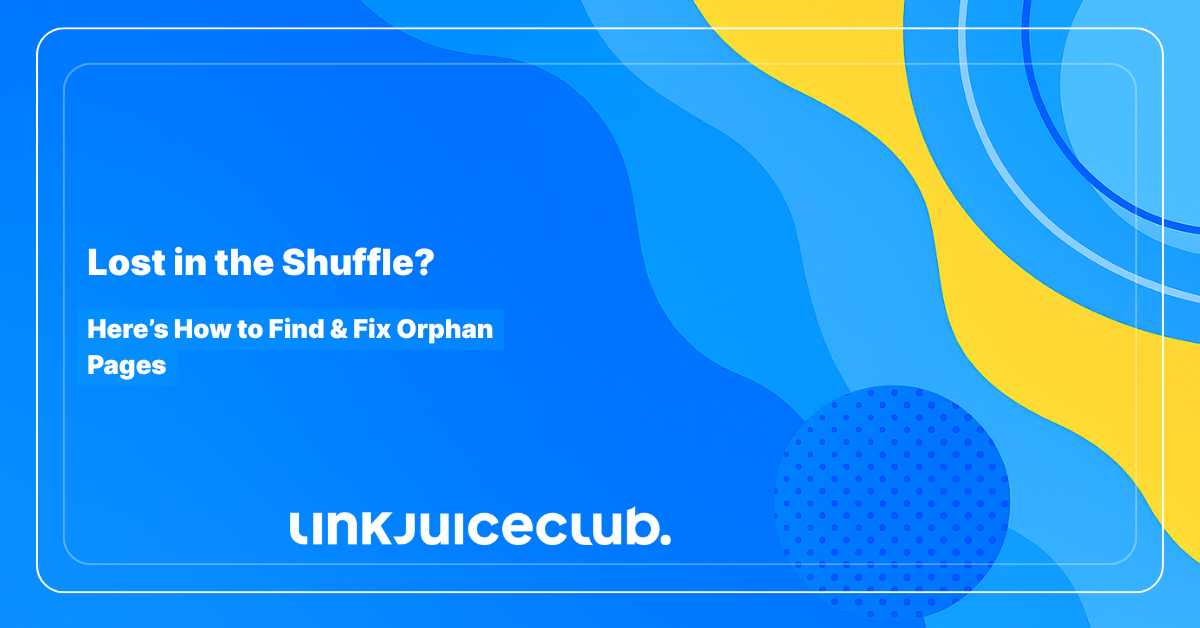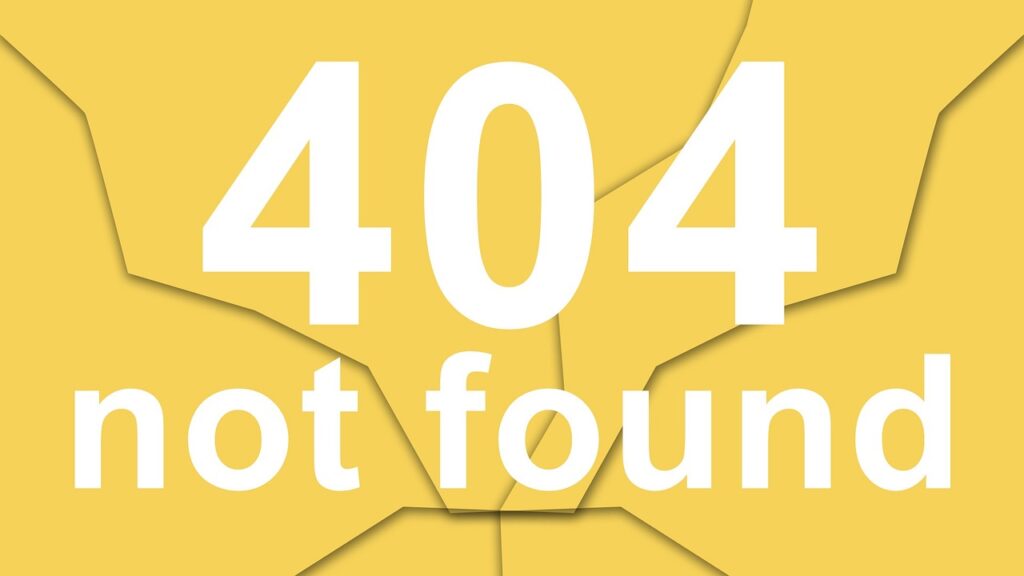
Lost in the Shuffle? Here’s How to Find & Fix Orphan Pages
Orphan pages aren’t just floating out there in the void — they’re quietly sabotaging your site from within. No internal links, no breadcrumbs, no handshakes. They sit invisible, disconnected from your site’s ecosystem, and guess what? That means Google might never meet them either.
These pages:
- Exist on your domain,
- Might even be indexed,
- But get zero love from your internal linking structure.
👉 That’s like throwing a party but forgetting to send out invitations.
For example:
- You add a killer product page, but don’t hook it into your main category? Boom — orphaned.
- You delete a blog post that linked to others? Those others might now be stranded.
And while Google can stumble across them via backlinks or direct access, you’re playing roulette with your visibility. Not a game you want to play.

💡 Let’s fix that.
What Really Makes a Page an Orphan?
Let’s cut through the noise: an orphan page is one that lives on your website but has no internal links pointing to it. No shoutouts from the homepage, no nod from the nav bar, not even a whisper from blog posts or category hubs.
But wait — it gets trickier.
Even if a page is linked… but only by other lost souls (i.e., orphan pages themselves), it’s still functionally orphaned. Why? Because there’s no pathway from the core site structure to those pages. They’re hidden in plain sight.
🔍 Picture this:
- Example A: You publish a “Customer Onboarding Checklist” and link it only from an old thank-you page. That thank-you page? Orphaned. So your checklist is buried with it.
- Example B: You run a seasonal landing page for a promo. It links to FAQs, testimonials, and a bonus video — but no other page on your site links back to that promo hub. The whole cluster becomes an isolated island.
Here’s the formula:
If a page isn’t connected to your site’s main navigation flow, it’s off the map — and off the radar for Google and your users.
🚫 What It’s Not: Don’t confuse this with dead-end pages. These are pages that don’t link out, but may still be well-linked to. Think product pages with no “Related Products” or blog posts that don’t link forward. They’re not orphaned — just selfish.
When It’s Actually Okay to Have Orphan Pages
Not every orphan page is a mistake — some are strategically left in the shadows.
These are your:
- 🎯 Paid ad landing pages (you don’t want them discoverable outside the campaign),
- 🕵️♀️ Gated resources for email subscribers or affiliates,
- 🧾 Confirmation pages (like “Thanks for subscribing!” or post-purchase screens),
- 🚧 Early-stage content drafts or A/B test variants not meant for prime time yet.
These pages are designed to fly under the radar, only accessible by direct links — and that’s the point. You wouldn’t want your homepage leading users to a one-time Black Friday deal from last year, right?
Can Google Still Index Orphan Pages?
Yes — but it’s not something you should bank on.
If Google finds an orphan page through:
- 🔗 External backlinks,
- 📬 Direct URL input,
- 🗺️ Your XML sitemap,
…then yes, it can crawl and index it.
But here’s the problem: Without internal links pointing to it, that page sends zero SEO signals. It won’t benefit from your site’s topical authority, internal PageRank flow, or crawl prioritization.
🧠 Think of it this way:
Google sees your sitemap like a list of ingredients — but your internal links are the actual recipe.
So if your strategy relies solely on sitemaps or random backlinks? You’re leaving your site’s performance up to chance.
✅ Best Practice: Even if a page can be indexed without internal links, always ask yourself — should it be?
Why Orphan Pages Wreck Your SEO (and Your Site’s Momentum)
Orphan pages don’t just get lost — they slow you down, quietly and consistently. Every one of them is a dead weight dragging on your rankings, traffic, and user experience.
Let’s break down how they do real damage.
They’re Invisible to Google — and That’s a Big Deal
- Internal links are how search engines crawl your site. Orphan pages? They’re off the grid.
- No internal links = no crawl path = no indexing = no rankings.
Even if Google stumbles across them through a sitemap or backlink, orphan pages:
- Don’t benefit from internal authority flow,
- Lack contextual signals (topical relevance),
- Rarely rank competitively — if at all.
They Tank Your Organic Traffic Potential
No visibility means no traffic.
No traffic means no clicks.
No clicks means no conversions.
- Orphan pages often sit in a traffic vacuum — no internal links means they’re not discoverable by users or bots.
- Even when indexed, they underperform because they’re not part of your internal link strategy — which Google uses to understand your content’s value.
🧠 Think of it like this: A blog post on page 7 of Google with no links? Might as well not exist.
They Hide Critical Content from Your Users
What’s the point of amazing content if no one can find it?
- That pricing page hidden behind an old campaign? Lost sales.
- A support article that solves a common user problem? Never seen.
- An abandoned lead magnet? Zero conversions.
These pages don’t just hurt SEO — they chip away at your user journey, which in turn hurts conversions, retention, and trust.
They Waste Crawl Budget (And That’s a Resource You Pay For)
Search engines don’t have unlimited attention spans.
- Large sites (think ecommerce, publishers, SaaS platforms) need to be extra careful — thousands of orphan pages can lead to crawl chaos.
- When Googlebot wastes time poking around isolated URLs, your important pages may get ignored or crawled less frequently.
Crawl budget issues don’t hit every site equally, but when they do, they hit hard. Clean internal architecture = more efficient crawling.
How to Track Down Orphan Pages (Before They Cost You Rankings)
Orphan pages don’t raise their hand. They hide in the corners, quietly bleeding your SEO potential.
And because they’re not linked from anywhere, you can’t just follow a breadcrumb trail to find them. But that doesn’t mean you’re stuck.
You just need the right tools — and a little method to the madness.
1. Use a Site Audit Tool (The Heavy-Hitter Method)
Most serious SEO platforms offer site auditing features that mimic how search engines crawl your site. They’ll uncover all the nooks, crannies — and yes, orphans.
Tools that get the job done:
- Semrush
- Ahrefs
- Screaming Frog
- Sitebulb
Let’s break it down using Semrush as an example:
- Start a new Site Audit project.
- Enter your domain and tweak the crawl settings (or leave as default).
- Run the crawl, then go to the “Issues” tab.
- Search for keywords like “orphan” or “no internal links.”
- You’ll see a list of flagged pages — inspect each to confirm.
🔧 You may need to integrate Google Analytics or Search Console for better accuracy. And yes, some false positives (like redirected URLs or parameter pages) may show up — ignore those.
Pro Move: Export the orphaned URLs list and sort by traffic to prioritize your fix list.
2. Use a WordPress Plugin (For the WP Warriors)
If your site runs on WordPress, plugins can help uncover orphan pages right inside your dashboard — no external tool required.
Rank Math is a standout for this.
Here’s how to do it:
- Go to Posts or Pages inside your WordPress dashboard.
- In the SEO Details column, look for the 🔗 “Incoming Links” icon.
- Pages or posts showing a big zero = 🚨 potential orphans.
- Hover for more detail — you’re hunting for internal links specifically.
🛠️ If the SEO Details column isn’t visible:
- Click “Screen Options” at the top right.
- Check “SEO Details”, then hit Apply.
📌 Heads up: Scanning manually works fine if you’ve got <100 pages. But for large sites? You’ll need pro tools — or the Pro version of Rank Math, which includes filters to surface orphan pages instantly.
How to Fix Orphan Pages (and Turn Them Into SEO Power Plays)
Once you’ve tracked down those digital drifters, it’s time to make a choice: revive, redirect, restrict — or remove. The fix depends on why the page became an orphan in the first place.
Here’s how to tackle them like a pro.
1. Add Internal Links (Bring Them Back Into the Fold)
Best for:
- New blog posts or guides,
- Pages with value that somehow got left out of the linking loop.
Example:
A freshly published case study with zero links pointing to it.
Fix:
Link to the orphan from:
- High-traffic, relevant blog posts,
- Pillar content or resource hubs,
- Contextually related product or service pages.
📌 Bonus: Internal links from top-performing pages pass the most SEO juice. Prioritize those.
2. Merge and Redirect (Recycle What Still Matters)
Best for:
- Semi-useful or outdated content,
- Pages with backlinks or historical traffic that don’t justify standing alone.
Example:
A “Top Productivity Tools of 2021” post collecting dust, while your new 2025 version is thriving.
Fix:
- Pull any evergreen bits into your updated post,
- Use a 301 redirect from the old orphan page to the new one,
- Preserve link equity while cleaning house.
🎯 Smart consolidation strengthens authority and reduces cannibalization.
3. Apply a “noindex” Tag (Hide It, Don’t Kill It)
Best for:
- Ad landing pages,
- Private member-only content,
- Temporary campaigns or test pages.
Example:
A PPC landing page with a special offer not meant for organic visitors.
Fix:
- Keep the page live for users,
- Add a noindex meta tag to block it from search results.
💡 This way, the page does its job — without clogging up your index or diluting your SEO strategy.
4. Delete the Page (When It’s Truly Worthless)
Best for:
- Pages with no traffic, no backlinks, and no value to repurpose.
Example:
An abandoned product page from 2018 with outdated specs and no stock in sight.
Fix:
- Remove it entirely,
- Return a 404 (Not Found) or 410 (Gone) status.
🧼 This keeps your site lean, improves crawl efficiency, and prevents users from stumbling into dead ends.
The Bottom Line: Keep Orphan Pages Out of Your SEO Story
Orphan pages might start small, but they can grow into serious SEO dead zones if left unchecked.
Here’s what to lock in:
- 🧠 Prevention beats repair. Build internal linking into your content workflow — from day one, not after publishing.
- 🔗 Always link new pages intentionally. Every page deserves a path in and out.
- 🔎 Use smart tools and site search hacks. A quick site:yourdomain.com “keyword” on Google can uncover hidden content opportunities to link internally.
- 🛡️ Train your team. Writers and editors should treat internal linking as part of the writing craft, not an afterthought.
Keeping orphan pages out of your SEO mix isn’t just good housekeeping — it’s a growth multiplier. Stay connected, stay indexed, and make every page count.





